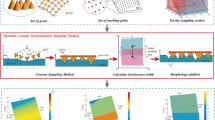Abstract
In the process of grinding, rubbing, plowing, and cutting occur successively between abrasive grains and workpiece material as the grinding depth increases. In precision grinding of the screw rotor, small grinding depth is generally introduced, which usually results in plowing. Therefore, it is essential to predict the surface roughness caused by plowing in order to make the process controllable. In this paper, an analytical method for predicting tooth surface roughness of the screw rotor in precision grinding has been proposed. This method takes the following factors into consideration, i.e., distribution law of the grain protrusion heights, variation of grinding depth, velocities and diameters of the screw rotor and grinding wheel at different contact points, and the dressing parameters of grinding wheel. A trajectory projection method has been employed to determine the groove depth and distribution left by the abrasive grains. With the proposed model, the distribution of roughness over the screw rotor tooth surface can be calculated. Verification experiments were conducted with several screw motors produced and surface roughness measured. The comparison results reveal a good agreement between predicted results and experimental results, showing the effectiveness of the proposed method. This study could shed light on the plowing phenomena in precision grinding and could provide great potential in achieving an effective control of the surface roughness.
Similar content being viewed by others
References
Wei J, Zhang G (2010) A precision grinding method for screw rotors using CBN grinding wheel. Int J Adv Manuf Technol 48:495–503
Wu Y-R, Fan C-W (2013) Mathematical modeling for screw rotor form grinding on vertical multi-axis computerized numerical control form grinder. J Manuf Sci Eng 135:051020
Tao L, Wang Y, He Y, Feng H, Yi O, Wang X (2016) A numerical method for evaluating effects of installation errors of grinding wheel on rotor profile in screw rotor grinding. Proc Inst Mech Eng Part B J Eng Manuf 230:1381–1398
Zhao Y, Zhao S, Wei W, Hou H (2017) Precision grinding of screw rotors using CNC method. Int J Adv Manuf Technol 89:2967–2979
Ono, K. (1985) Cutting theories. National Defense Industry Press, Beijing, China. (Language: Chinese)
Zhou X, Xi F (2002) Modeling and predicting surface roughness of the grinding process. Int J Mach Tools Manuf 42:969–977
Gong YD, Wang B, Wang WS (2002) The simulation of grinding wheels and ground surface roughness based on virtual reality technology. J Mater Process Technol 129:123–126
Hecker RL, Liang SY (2003) Predictive modeling of surface roughness in grinding. Int J Mach Tools Manuf 43:755–761
Agarwal S, Rao PV (2010) Modeling and prediction of surface roughness in ceramic grinding. Int J Mach Tools Manuf 50:1065–1076
Jiang JL, Ge PQ, Bi WB, Zhang L, Wang DX, Zhang Y (2013) 2D/3D ground surface topography modeling considering dressing and wear effects in grinding process. Int J Mach Tools Manuf 74:29–40
Chen H, Tang J, Zhou W (2013) Modeling and predicting of surface roughness for generating grinding gear. J Mater Process Technol 213:717–721
Wang YZ, Chen YY, Zhou GM, Lv QJ, Zhang ZZ, Tang W (2016) Roughness model for tooth surfaces of spiral bevel gears under grinding. Mech Mach Theory 104:17–30
Ming X, Gao Q, Yan H, Liu J, Liao C (2016) Mathematical modeling and machining parameter optimization for the surface roughness of face gear grinding. Int J Adv Manuf Technol 90:2453–2460
Wang X, Yu T, Dai Y, Shi Y, Wang W (2016) Kinematics modeling and simulating of grinding surface topography considering machining parameters and vibration characteristics. Int J Adv Manuf Technol 87:2459–2470
Lipiński D, Bałasz B (2018) Modelling of surface roughness and grinding forces using artificial neural networks with assessment of the ability to data generalisation. Int J Adv Manuf Technol 94:1335–1347
Wu X (2009) Theory of gearing. Xi’an Jiaotong University Press, Xi’an, China. (Language: Chinese)
Hou ZB, Komanduri R (2003) On the mechanics of the grinding process – Part I. Stochastic nature of the grinding process. Int J Mach Tools Manuf 43:1579–1593
Norton Company. 1978. Standard stock and specifications manual.
Norton Quantum 3 - Norton Abrasives https://www.nortonabrasives.com/sites/sga.na.com/files/document/NQ3_IND_NPL_White_Paper_NAM_rev2.pdf?t=597777
ISO 4288 (1996) Geometrical product specifications (GPS) – Surface texture: profile method – rules and procedures for the assessment of surface texture. International Organization for Standardization, Geneva
Funding
This work was financially supported by the National Natural Science Foundation of China (grant number 51575069), The National Key Research and Development Program of China (grant number2018YFB1701203).
Author information
Authors and Affiliations
Corresponding author
Additional information
Publisher’s note
Springer Nature remains neutral with regard to jurisdictional claims in published maps and institutional affiliations.
Rights and permissions
About this article
Cite this article
Liu, Z., Tang, Q., Zhang, Y.F. et al. An analytical method for surface roughness prediction in precision grinding of screw rotors. Int J Adv Manuf Technol 103, 2665–2676 (2019). https://doi.org/10.1007/s00170-019-03598-1
Received:
Accepted:
Published:
Issue Date:
DOI: https://doi.org/10.1007/s00170-019-03598-1



